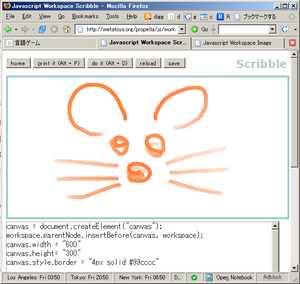Active Essays is a concept of an essay mixed with computer program coined by Alan Kay. The goal is to explain mathematical or scientific ideas to kids with some interesting program like a computer simulation.
It is similar as a math book which includes a couple of paragraphs and formulas in a page, so that a reader would follow the author's idea by not only reading a text but also "do it" formulas. In case of Active Essays, computer programs are embedded in a page instead of formulas. The largest advantage of Active Essays to math book is that a program is often more dynamic than a formula. It is really fun to see a small lines of code generating a little surprise on screen. The second advantage would be that you don't have to calculate numbers by yourself, a computer must to do better job than you to fiddle variables.
Because Active Essay is not a definitive genre in computer media, so I'm not sure how many active essays have ever been written so far. But HyperCard might be the first media which affords contents mixed with text and program. And you would find many projects with this style in eToys on the web.
What I want to make in next a couple of months is an authoring tool for Active Essays taking advantage of Internet technology. And final goal is to describe entire system as a Active Essay itself.
Internet had a huge impact on our literacy. A lot of amateurs write texts, take photos, and publish to the web them every day. Even it is common that there are families whose every members have each blog. Besides social aspect, a new medium makes a new style of writing. Because actual appearance of writing is depended on reader's web browser or RSS reader, you don't have a full control of final looking of your text. And it is encouraged to take care about logical stricture instead of physical looking. I'm sure the those phenomena affects way of writing.
However, there is a something what have not been changed yet. Internet contents still tend to mimic traditional media. Even though it is highly depend on computer technology, it lacks the most interesting aspect, programming language as a communication media.
Programming language is the primary tool to talk between man and machine, and often even better way to exchange ideas among humans. If there were enough support tools, it would be natural that we write a blog post in programming language, chat with source code, and even write a novel running as a program. Especially when the topic is science or mathematics, programming language would be the most accurate way to tell an idea. It is irony that you can't play a LOGO program when you read LOGO's article on Wikipedia.
However, e.g. while the article on Logo has some good information and examples, none on them can be run, dynamically changed and tried, etc. To me this is outrageous given that the browser was done some years after Hypercard, longer after the Apple ][, and long long after the prior art of the 60s and 70s. -- Alan Kay
What kind of tool is useful to support the idea? Abundant introductory material for science written in eToys would be a good start to examine. And history of Literate Programming shows another interesting aspect of the topic. We would make a progress from these instances in terms of functionality and style.
As functionality, Don Knuth's original idea could evolve more in late binding language like JavaScript than Pascal or C, because WEB's some clumsy convention like macro is needed only for language's inflexibility. And as style, we can avoid limitation coming from physical paper. We don't have to care about pages nor font size, but let's concentrate its logical structure. Hyper link helps to support navigating in random access instead of page numbers.
This is an outline of current thought. I don't think special fancy feature is needed for first prototype (actually, I have made a lot of prototypes already, and this is not exactly the first). The simplest solution might be best. And when we need more, I would make everything from scratch in "Ian's System" later.
- Active Essays: http://www.squeakland.org/whatis/a_essays.html
- About LogoWiki: http://www.redhat.com/archives/olpc-software/2006-April/msg00035.html

